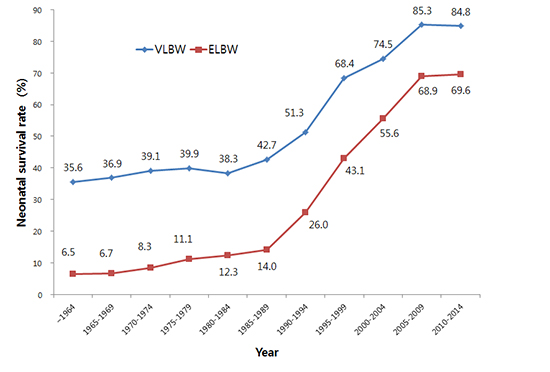Abstract
Graphical Abstract

Figures and Tables
Fig. 1
Flow chart depicting the process of study. *Data acquisition from Kim et al., Korean J Pediatr 2008 (reference 17); †data acquisition from Park et al., J Korean Soc Neonatol 2004 (reference 5); ‡data acquisition from Hahn et al., J Korean Soc Neonatol 2009 (reference 6); §data acquisition from Hahn et al., J Korean Med Sci 2011 (reference 7).

Fig. 2
Changes of neonatal survival rates for very-low-birth-weight infants (VLBWI) and extremely low birth weight infants (ELBWI) in Korea (1960-2014. 6.). *P < 0.05 vs. late 1960s; †P < 0.001 vs. late 1960s; ‡P < 0.05 vs. late 1960s; §P < 0.001 vs. late 1960s; ∥data acquisition from Kim et al., Korean J Pediatr 2008 (reference 17); Park et al., J Korean Soc Neonatol 2004 (reference 5); Hahn et al., J Korean Soc Neonatol 2009 (reference 6) and Hahn et al., J Korean Med Sci 2011 (reference 7). ELBWI, extremely low birth weight infants; VLBWI, very-low-birth-weight infants.

Fig. 3
Changes of neonatal survival rates by gestational period in Korea (2002-2014. 6). *P < 0.015, 2007 vs. 2002; †P < 0.015, 2009 vs. 2002; ‡P < 0.015, 2013-2016.6 vs. 2002; §data acquisition from Park et al., J Korean Soc Neonatol 2004 (reference 5); ∥data acquisition from Hahn et al., J Korean Soc Neonatol 2009 (reference 6); ¶data acquisition from Hahn et al., J Korean Med Sci 2011 (reference 7).

Fig. 4
Comparison of neonatal survival rate in Korea, Japan, Europe, Canada, and Autralia-New Zealand by very-low-birth-weight infants (VLBWI) and extremely low birth weight infants (ELBWI). *P < 0.05 comparison to the KNN reference birth weight specific survival rates. KNN, Korean Neonatal Network; NRNJ, Neonatal Research Network of Japan (reference 20); NICHD, National Institute of Child Health and Human Development Neonatal Research Network (U.S., reference 11); CNN, Canadian Neonatal Network (reference 21); AZN, Australia-New Zealand Neonatal Network (reference 22); EuroNeoNet, European Neonatal Network (reference 23); ELBWI, extremely low birth weight infants; VLWBI, very-low-birth-weight infants.

Table 1
Neonatal survival rates of very-low-birth-weight infants (VLBWI) and extremely low birth weight infants (ELBWI) in the Korea by the 2013-2014. 6. Korean Neonatal Network

Table 2
Comparison of neonatal survival rates of very-low-birth-weight infants (VLBWI) between adjacent gestational age in Korea

*Data acquisition from Park et al., J Korean Soc Neonatol 2004 (reference 5); †data acquisition from Hahn et al., J Korean Soc Neonatol 2009 (reference 6); ‡data acquisition from Hahn et al., J Korean Med Sci 2011 (reference 7); §current KNN study. GA, gestational age; SR, survival rate.
Table 3
Comparison of survival rates according to birth weight for very-low-birth-weight infants (VLBWI) in networks from Korea, Japan, USA, Canada, Australia-New Zealand and European countries

*P<0.05 comparison to the KNN reference birth weight specific survival rates; †P<0.001 comparison to the KNN reference birth weight specific survival rates. ELBWI; extremely low birth weight infants, VLWBI; very-low-birth-weight infants, KNN; Korean Neonatal Network, NRNJ; Neonatal Research Network of Japan (reference 20), VON; Vermont Oxford Network (reference 11), CNN; Canadian Neonatal Network (reference 21), AZN; Australia-New Zealand Neonatal Network (reference 22), EuroNeoNet; European Neonatal Network (reference 23).
Table 4
Comparison of neonatal survival rate according to gestational age for very-low-birth-weight infants in 6 networks form Korea, USA, Canada, Australian-New Zealand, and Europe countries

*P<0.05 comparison to the KNN reference birth weight specific survival rates; †P<0.001 comparison to the KNN reference birth weight specific survival rates. GA, gestational age, KNN; Korean Neonatal Network, NRNJ; Neonatal Research Network of Japan (reference 20), NICHD; National Institute of Child Health and Human Development Neonatal Research Network (U.S. (reference 1), CNN; Canadian Neonatal Network (reference 21), AZN; Australia-New Zealand Neonatal Network (reference 22), EuroNeoNet; European Neonatal Network (reference 23).




 PDF
PDF Citation
Citation Print
Print



 XML Download
XML Download